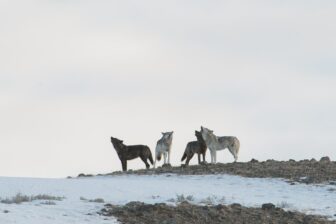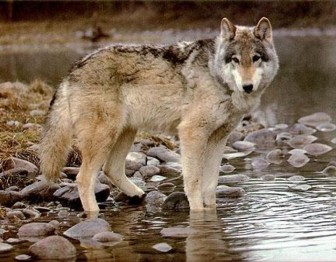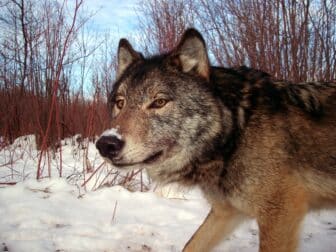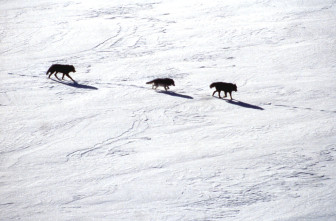
Gray Wolves
While gray wolves have rebounded from near-total extinction in parts of the Northern Rockies and Western Great Lakes regions, much of the country’s suitable habitat remains unoccupied by wolves. The recovery in areas where they do currently exist was only possible because of the protections provided by the Endangered Species Act.
In spite of this current, unfinished state of gray wolf recovery, the Biden Administration is continuing the previous administration’s policy of stripping Endangered Species Act protections from most of the wolves in the lower-48. Taking away these safeguards will hinder future progress by allowing states to set hunting and trapping seasons or even treat wolves as nuisance animals to be shot on sight.
We know that wolves rely on dispersing members of packs in neighboring areas to expand. It’s what has allowed the wolves initially reintroduced into Yellowstone to grow to become a stable population in neighboring states.
The wolf known to researchers as OR-7, or to most everyone else as Journey, is perhaps the most famous example of a wolf that explored new and far-away lands.
He was born in Northeast Oregon in 2011 and journeyed all the way into California. This epic exploration made him the first wolf to cross into California in nearly 90 years.
We need to lay the groundwork for other wolves like Journey to be able to freely and safely expand into new habitats.
While gray wolves have rebounded from near-total extinction in parts of the Northern Rockies and Western Great Lakes regions, much of the country’s suitable habitat remains unoccupied by wolves. The recovery in areas where they do currently exist was only possible because of the protections provided by the Endangered Species Act.
In spite of this current, unfinished state of gray wolf recovery, the Biden Administration is continuing the previous administration’s policy of stripping Endangered Species Act protections from most of the wolves in the lower-48. Taking away these safeguards will hinder future progress by allowing states to set hunting and trapping seasons or even treat wolves as nuisance animals to be shot on sight.
We know that wolves rely on dispersing members of packs in neighboring areas to expand. It’s what has allowed the wolves initially reintroduced into Yellowstone to grow to become a stable population in neighboring states.
The wolf known to researchers as OR-7, or to most everyone else as Journey, is perhaps the most famous example of a wolf that explored new and far-away lands.
He was born in Northeast Oregon in 2011 and journeyed all the way into California. This epic exploration made him the first wolf to cross into California in nearly 90 years.
We need to lay the groundwork for other wolves like Journey to be able to freely and safely expand into new habitats.
Red Wolves
Red wolves are one of the most endangered species on the planet. While they once thrived across the southeastern United States, there are around 20 red wolves alive in the wild today.
Overly aggressive predator management actions drove them to be declared biologically extinct in the wild in 1980. Restoration attempts began later that decade with the release of four pairs of wolves in North Carolina. Those wolves grew the wild population gradually to around 100 in 2014 but political interference has sandbagged recovery efforts and caused that number to drop to around 20 today.
This is a critical time for the future of this species, but the U.S. Fish & Wildlife Service (USFWS) has ceased virtually all efforts to save wild red wolves, focusing on wolves in captivity. There was an encouraging legal victory in October of 2020 that will force the USFWS to update its plan for saving these wolves.
Red wolves are one of the most endangered species on the planet. While they once thrived across the southeastern United States, there are around 20 red wolves alive in the wild today.
Overly aggressive predator management actions drove them to be declared biologically extinct in the wild in 1980. Restoration attempts began later that decade with the release of four pairs of wolves in North Carolina. Those wolves grew the wild population gradually to around 100 in 2014 but political interference has sandbagged recovery efforts and caused that number to drop to about 20 wolves today.
This is a critical time for the future of this species, but the U.S. Fish & Wildlife Service (USFWS) has ceased virtually all efforts to save wild red wolves, focusing on wolves in captivity. There was an encouraging legal victory in October of 2020 that will force the USFWS to update its plan for saving these wolves.
Mexican Gray Wolves
The Mexican gray wolf (or el lobo) is the most endangered wolf subspecies in the world. Native to the mountainous woodlands of the southwestern United States and northern Mexico, this rare canine suffered habitat loss and other human impacts so great that it has been effectively absent from the American landscape for more than half a century.
Intensive expansion into the American Southwest in the early 20th century marked the beginning of the end for Mexican gray wolves in the United States. With settlement and its related activities reducing natural prey populations, wolves increasingly turned to domestic livestock for food. Threatening livestock operations and perceived-threat to human settlement in general meant an all out war against the Mexican gray wolf. By mid-century Americans had achieved their goal of culling this gray-and-brown coated predator and Mexican gray wolves were eradicated in the Southwest. The wolves’ numbers in Mexico were also greatly reduced throughout the 1900s, making repopulation by migration all the more difficult.
Today, threats from compromised genetics, human intolerance, and insufficient release of captive-bred wolves into the wild are stalling recovery. There are just 163 Mexican gray wolves in the wild in the states of Arizona and New Mexico today.
The Mexican gray wolf (or el lobo) is the most endangered wolf subspecies in the world. Native to the mountainous woodlands of the southwestern United States and northern Mexico, this rare canine suffered habitat loss and other human impacts so great that it has been effectively absent from the American landscape for more than half a century.
Intensive expansion into the American Southwest in the early 20th century marked the beginning of the end for Mexican gray wolves in the United States. With settlement and its related activities reducing natural prey populations, wolves increasingly turned to domestic livestock for food. Threatening livestock operations and perceived-threat to human settlement in general meant an all out war against the Mexican gray wolf. By mid-century Americans had achieved their goal of culling this gray-and-brown coated predator and Mexican gray wolves were eradicated in the Southwest. The wolves’ numbers in Mexico were also greatly reduced throughout the 1900s, making repopulation by migration all the more difficult.
Today, threats from compromised genetics, human intolerance, and insufficient release of captive-bred wolves into the wild are stalling recovery. There are just 163 Mexican gray wolves in the wild in the states of Arizona and New Mexico today.
Recent Wolf Updates




For Immediate Release: Judge Upholds Ruling Limiting Wolf Trapping, Snaring in Idaho

